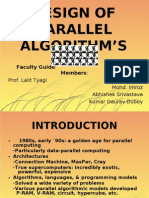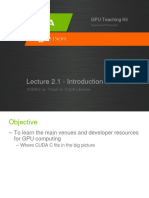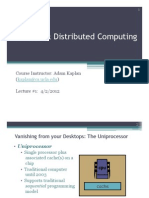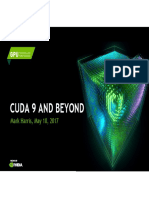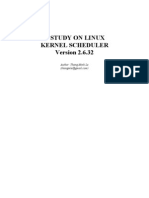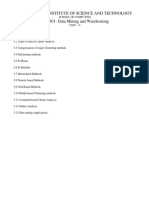Accelerating CUDA Graph Algorithms at Maximum Warp
Uploaded by
thangmleAccelerating CUDA Graph Algorithms at Maximum Warp
Uploaded by
thangmleAccelerating CUDA Graph Algorithms at Maximum Warp
By: Sungpack Hong, Sang Kyun Kim, Tayo Oguntebi, Kunle Olukotun
Presenter: Thang M. Le
Authors
Sungpack Hong
Ph.D graduate from Stanford Currently, a principal member of technical staff at Oracle
Sang Kyun Kim
Ph.D candidate at Stanford
Tayo Oguntebi
Ph.D candidate at Stanford
Kunle Olukotun Professor of Electrical Engineering & Computer Science at Stanford Director of Pervasive Parallel Laboratory
Agenda
What Is the Problem? Why Does the Problem Exist? Warp-Centric Programming Method Other Techniques Experimental Results Study of Architectural Effects Q&A
What Is the Problem?
The Parallel Random Access Machine (PRAM) abstract is often used to investigate theoretical parallel performance of graph algorithm PRAM approximation is quite accurate in supercomputer domains such as Cray XMT PRAM based algorithms fail to perform well on GPU architectures due to the workload imbalance among threads
Why Does the Problem Exist?
CUDA thread model exhibits certain discrepancies with the GPU architecture
Notably, no explicit notion of warps Different behaviors when accessing memory
Requests targeting the same address are merged Spatial locality accesses are maximally coalesced All other memory requests are serialized
Why Does the Problem Exist?
SIMT eliminates SIMD constraints by allowing threads in a warp to pursue on different paths (aka path divergence) Path divergence provides more flexibilities at the cost of performance Path divergence leads to hardware underutilization
Scattering memory access patterns
Why Does the Problem Exist?
A thread that processes a high-degree node will iterate the loop at line 23 many more times than other threads, stalling other threads in the warp
Path divergence
Why Does the Problem Exist?
Non-coalesced memory
Warp-Centric Programming Method
A program can be run in either SISD phase or SIMT phase:
SISD:
all threads in a warp are executed on the same data degree of parallelism (per SM) = O(# concurrent warps) Each thread is executed on different data degree of parallelism (per SM) = O(# threads in a warp x # concurrent warps)
SIMT:
By default, all threads in a warp are executed following SISD When appropriate, switch to SIMT to exploit data parallelism
Warp-Centric Programming Method
Is it safe to run a logic in SISD on GPU architecture?
methodA
input
output
Since methodA will be executed many times by different threads on the same input, the logic of methodA must be deterministic to guarantee the correctness in SISD phase
Warp-Centric Programming Method
Advantages:
No path divergence Increase memory coalescing Allows to take advantage of shared memory
Warp-Centric Programming Method
Warp-Centric Programming Method
Traditional approach: thread-to-data
mapping Threads 0 1 2 3 4 5 . . . . n-2 n-1 n
Level[ ] 0 1 2 3 4 5 . . . . n-2 n-1 n
Warp-Centric Programming Method
Warp-centric approach: warp-to-chunk of data
Chunks 0 Warps Threads 0 0 1 2 3 1 1 4 5 . . . . n-2 k k n-1 n
Level[ ] 0 1 2 3 4 5 . . . . n-2 n-1 n
mapping
Warp-Centric Programming Method
Warp-centric approach: warp-to-chunk of data
Coarse-grained mapping Each chunk must be mapped to a warp Number of chunks Number of warps Chunk size & warp size are independent Chunk size is limited by the size of shared memory
Warp-Centric Programming Method
Disadvantages:
If native SIMT width of the user application is small, the underlying hardware will be under-utilized (# threads assigned to data < #physical cores)
Warp-Centric Programming Method
Disadvantages:
The ratio of the SIMT phase duration to the SISD phase duration imposes an Amdahls limit on performance
Amdahls Law:
Improvement:
Warp-Centric Programming Method
Addressing these issues:
Partition a warp into multiple virtual warps with smaller size
Virtual warp size =
Increase parallelism within the SISD phase Improve ALU utilization by O(K) times Drawback: might re-introduce path divergence among these multiple virtual warps. This is the trade-off between path divergence and ALU utilization.
Other Techniques
Deferring Outliners:
Define some threshold Defer processing any node having degree greater than the threshold Process outliners in a separate kernel method
Dynamic Workload Distribution:
Virtual warp-centric does not prevent work imbalance among warps in a block Each warp fetches a chunk of work from shared work queue Trade-off between static/dynamic chunk of work:
static work distribution suffers from work imbalance dynamic work distribution imposes overhead
Experimental Results
Input Graphs:
RMAT: scale-free graph which follows a power law degree distribution like many real world graph. The average vertex degree is 12. RANDOM: uniformly distributed graph instance created by randomly connecting m pairs of nodes out of total n nodes. The average vertex degree is 12. LiveJournal: real world graph, is a very irregular structure Patent: is relatively regular graph, has a smaller average degree
Experimental Results
Experimental Results
Study of Architectural Effects
Advantages of GPU Architecture
Enables massively parallel execution Uses large number of warps to hide memory latency Uses GDDR3 memory which has higher bandwidth and lower latency than FB-DIMM based CPU main memory
Study of Architectural Effects
Effect of bandwidth utilization and latency hiding in GPUs
Conclusion:
Graph algorithms are bound by memory bandwidth
Last But Not Least
A supercomputer is a device for turning compute-bound problems into I/O-bound problems Ken Batcher
You might also like
- A Note On Goldberg and Rao Algorithm For The Maximum Flow ProblemNo ratings yetA Note On Goldberg and Rao Algorithm For The Maximum Flow Problem9 pages
- Design of Parallel Algorithm'S: Faculty Guide: Group MembersNo ratings yetDesign of Parallel Algorithm'S: Faculty Guide: Group Members49 pages
- How CUDA Programming Works - 1647539841016001sz6eNo ratings yetHow CUDA Programming Works - 1647539841016001sz6e101 pages
- Parallel Architecture: Sathish VadhiyarNo ratings yetParallel Architecture: Sathish Vadhiyar26 pages
- Khaitan PSERC Webinar HPC Mar 2013 SlidesNo ratings yetKhaitan PSERC Webinar HPC Mar 2013 Slides52 pages
- Improving GPU Performance Via Large Warps and Two-Level Warp SchedulingNo ratings yetImproving GPU Performance Via Large Warps and Two-Level Warp Scheduling10 pages
- CUDA, Supercomputing For The Masses: Part 4: Understanding and Using Shared MemoryNo ratings yetCUDA, Supercomputing For The Masses: Part 4: Understanding and Using Shared Memory3 pages
- Cs344 - Lesson 2 - GPU Hardware and Parallel Communication Patterns - UdacityNo ratings yetCs344 - Lesson 2 - GPU Hardware and Parallel Communication Patterns - Udacity14 pages
- We Are Intechopen, The World'S Leading Publisher of Open Access Books Built by Scientists, For ScientistsNo ratings yetWe Are Intechopen, The World'S Leading Publisher of Open Access Books Built by Scientists, For Scientists41 pages
- Benchmarking the cost of thread divergence in CUDANo ratings yetBenchmarking the cost of thread divergence in CUDA8 pages
- Gujarat Technological University: W.E.F. AY 2018-19No ratings yetGujarat Technological University: W.E.F. AY 2018-193 pages
- CI-0120 Arquitectura de Computadoras Ejemplos FundamentosDiseñoNo ratings yetCI-0120 Arquitectura de Computadoras Ejemplos FundamentosDiseño52 pages
- Additional Topics of Unit-I and Unit-II: Syed Rameem ZahraNo ratings yetAdditional Topics of Unit-I and Unit-II: Syed Rameem Zahra21 pages
- NVIDIA - Cooperative Groups - Slides - GTC 2017 (S7622-Kyrylo-Perelygin-Robust-And-Scalable-Cuda)No ratings yetNVIDIA - Cooperative Groups - Slides - GTC 2017 (S7622-Kyrylo-Perelygin-Robust-And-Scalable-Cuda)56 pages
- CS 133 Parallel & Distributed Computing: Course Instructor: Adam Kaplan Lecture #1: 4/2/2012No ratings yetCS 133 Parallel & Distributed Computing: Course Instructor: Adam Kaplan Lecture #1: 4/2/201222 pages
- Lecture 12 Exascale, Quantum Computing, Review (2)No ratings yetLecture 12 Exascale, Quantum Computing, Review (2)38 pages
- A Study of Performance Programming of CPU, GPU Accelerated Computers and SIMD ArchitectureNo ratings yetA Study of Performance Programming of CPU, GPU Accelerated Computers and SIMD Architecture19 pages
- GPU Computing CIS-543: Lecture 08: CUDA Memory ModelNo ratings yetGPU Computing CIS-543: Lecture 08: CUDA Memory Model50 pages
- 2-INTRODUCTION TO PDC - MOTIVATION - KEY CONCEPTS-03-Dec-2019Material - I - 03-Dec-2019 - Module - 1 PDFNo ratings yet2-INTRODUCTION TO PDC - MOTIVATION - KEY CONCEPTS-03-Dec-2019Material - I - 03-Dec-2019 - Module - 1 PDF63 pages
- Scanline Rendering: Exploring Visual Realism Through Scanline Rendering TechniquesFrom EverandScanline Rendering: Exploring Visual Realism Through Scanline Rendering TechniquesNo ratings yet
- A Study On Windows Mobile 6.5 Operation SystemNo ratings yetA Study On Windows Mobile 6.5 Operation System13 pages
- Ergonomic Design and Analysis of A Post in A Stall: Article InformationNo ratings yetErgonomic Design and Analysis of A Post in A Stall: Article Information10 pages
- Academic Year 2021-22 Scheme and SyllabusNo ratings yetAcademic Year 2021-22 Scheme and Syllabus49 pages
- ISA Transactions: Peyman Sindareh Esfahani, Jeffrey Kurt PieperNo ratings yetISA Transactions: Peyman Sindareh Esfahani, Jeffrey Kurt Pieper11 pages
- Continuous RV Probability DistributionsNo ratings yetContinuous RV Probability Distributions51 pages
- Addition and Subtraction Workbook Grade 1, 5 Minute Drill0% (1)Addition and Subtraction Workbook Grade 1, 5 Minute Drill152 pages
- The Bounded Convergence Theorem - Brian ThomsonNo ratings yetThe Bounded Convergence Theorem - Brian Thomson22 pages
- Thornton Et Al. - 2019 - Developing Athlete Monitoring Systems in Team SporNo ratings yetThornton Et Al. - 2019 - Developing Athlete Monitoring Systems in Team Spor27 pages
- Download An Introductory Course on Mathematical Game Theory and Applications 2nd Edition González-Díaz ebook All Chapters PDF100% (4)Download An Introductory Course on Mathematical Game Theory and Applications 2nd Edition González-Díaz ebook All Chapters PDF40 pages
- Cambridge O Level: Mathematics (Syllabus D) 4024/21No ratings yetCambridge O Level: Mathematics (Syllabus D) 4024/2120 pages
- Teacher Job Satisfaction the Importance of School Working Conditions and Teacher CharacteristicsNo ratings yetTeacher Job Satisfaction the Importance of School Working Conditions and Teacher Characteristics28 pages
- Artificial Neural Networks Yegnanarayana PDF Downloadgolkes PDFNo ratings yetArtificial Neural Networks Yegnanarayana PDF Downloadgolkes PDF2 pages
- Computational Neural Networks Driving Complex Analytical Problem SolvingNo ratings yetComputational Neural Networks Driving Complex Analytical Problem Solving7 pages
- Sathyabama Institute of Science and Technology SIT1301-Data Mining and WarehousingNo ratings yetSathyabama Institute of Science and Technology SIT1301-Data Mining and Warehousing22 pages
- Structural Dynamics of Linear Elastic Multiple-Degrees-Of-Freedom ...100% (2)Structural Dynamics of Linear Elastic Multiple-Degrees-Of-Freedom ...125 pages
- A Note On Goldberg and Rao Algorithm For The Maximum Flow ProblemA Note On Goldberg and Rao Algorithm For The Maximum Flow Problem
- Design of Parallel Algorithm'S: Faculty Guide: Group MembersDesign of Parallel Algorithm'S: Faculty Guide: Group Members
- Improving GPU Performance Via Large Warps and Two-Level Warp SchedulingImproving GPU Performance Via Large Warps and Two-Level Warp Scheduling
- CUDA, Supercomputing For The Masses: Part 4: Understanding and Using Shared MemoryCUDA, Supercomputing For The Masses: Part 4: Understanding and Using Shared Memory
- Cs344 - Lesson 2 - GPU Hardware and Parallel Communication Patterns - UdacityCs344 - Lesson 2 - GPU Hardware and Parallel Communication Patterns - Udacity
- We Are Intechopen, The World'S Leading Publisher of Open Access Books Built by Scientists, For ScientistsWe Are Intechopen, The World'S Leading Publisher of Open Access Books Built by Scientists, For Scientists
- Benchmarking the cost of thread divergence in CUDABenchmarking the cost of thread divergence in CUDA
- Gujarat Technological University: W.E.F. AY 2018-19Gujarat Technological University: W.E.F. AY 2018-19
- CI-0120 Arquitectura de Computadoras Ejemplos FundamentosDiseñoCI-0120 Arquitectura de Computadoras Ejemplos FundamentosDiseño
- Additional Topics of Unit-I and Unit-II: Syed Rameem ZahraAdditional Topics of Unit-I and Unit-II: Syed Rameem Zahra
- NVIDIA - Cooperative Groups - Slides - GTC 2017 (S7622-Kyrylo-Perelygin-Robust-And-Scalable-Cuda)NVIDIA - Cooperative Groups - Slides - GTC 2017 (S7622-Kyrylo-Perelygin-Robust-And-Scalable-Cuda)
- CS 133 Parallel & Distributed Computing: Course Instructor: Adam Kaplan Lecture #1: 4/2/2012CS 133 Parallel & Distributed Computing: Course Instructor: Adam Kaplan Lecture #1: 4/2/2012
- Lecture 12 Exascale, Quantum Computing, Review (2)Lecture 12 Exascale, Quantum Computing, Review (2)
- A Study of Performance Programming of CPU, GPU Accelerated Computers and SIMD ArchitectureA Study of Performance Programming of CPU, GPU Accelerated Computers and SIMD Architecture
- GPU Computing CIS-543: Lecture 08: CUDA Memory ModelGPU Computing CIS-543: Lecture 08: CUDA Memory Model
- 2-INTRODUCTION TO PDC - MOTIVATION - KEY CONCEPTS-03-Dec-2019Material - I - 03-Dec-2019 - Module - 1 PDF2-INTRODUCTION TO PDC - MOTIVATION - KEY CONCEPTS-03-Dec-2019Material - I - 03-Dec-2019 - Module - 1 PDF
- Scanline Rendering: Exploring Visual Realism Through Scanline Rendering TechniquesFrom EverandScanline Rendering: Exploring Visual Realism Through Scanline Rendering Techniques
- Ergonomic Design and Analysis of A Post in A Stall: Article InformationErgonomic Design and Analysis of A Post in A Stall: Article Information
- ISA Transactions: Peyman Sindareh Esfahani, Jeffrey Kurt PieperISA Transactions: Peyman Sindareh Esfahani, Jeffrey Kurt Pieper
- Addition and Subtraction Workbook Grade 1, 5 Minute DrillAddition and Subtraction Workbook Grade 1, 5 Minute Drill
- Thornton Et Al. - 2019 - Developing Athlete Monitoring Systems in Team SporThornton Et Al. - 2019 - Developing Athlete Monitoring Systems in Team Spor
- Download An Introductory Course on Mathematical Game Theory and Applications 2nd Edition González-Díaz ebook All Chapters PDFDownload An Introductory Course on Mathematical Game Theory and Applications 2nd Edition González-Díaz ebook All Chapters PDF
- Cambridge O Level: Mathematics (Syllabus D) 4024/21Cambridge O Level: Mathematics (Syllabus D) 4024/21
- Teacher Job Satisfaction the Importance of School Working Conditions and Teacher CharacteristicsTeacher Job Satisfaction the Importance of School Working Conditions and Teacher Characteristics
- Artificial Neural Networks Yegnanarayana PDF Downloadgolkes PDFArtificial Neural Networks Yegnanarayana PDF Downloadgolkes PDF
- Computational Neural Networks Driving Complex Analytical Problem SolvingComputational Neural Networks Driving Complex Analytical Problem Solving
- Sathyabama Institute of Science and Technology SIT1301-Data Mining and WarehousingSathyabama Institute of Science and Technology SIT1301-Data Mining and Warehousing
- Structural Dynamics of Linear Elastic Multiple-Degrees-Of-Freedom ...Structural Dynamics of Linear Elastic Multiple-Degrees-Of-Freedom ...



